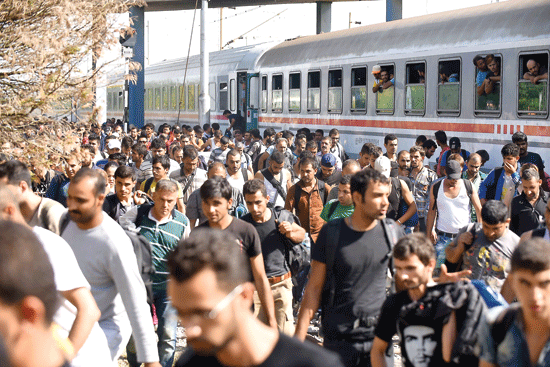

Tovarnik, Croatia: Overwhelmed Croatia yesterday began transporting thousands of migrants to its border with Hungary, admitting it cannot cope with the flood of humanity seeking a route through to northern Europe.
The move came as Budapest started building a new fence to keep them out, potentially setting up a new flashpoint in Europe’s worst migration crisis since the Second World War.
With no let-up in the flow of people desperate to find shelter in Europe, new figures showed the European Union had received almost a quarter of a million asylum requests in the three months to June.
And as another toddler’s body washed up on the shores of western Turkey, new figures from the International Organization for Migration (IOM) showed that nearly 474,000 people had so far this year braved perilous trips across the Mediterranean to reach Europe.
With Europe’s cherished borderless travel zone in tatters, the continent has been wrangling over how to handle the influx, with eastern states ruling out an EU quota plan for sharing out the burden.
After EU frontline state Hungary sealed off its southern border with Serbia earlier this week, thousands of migrants and refugees have now headed westwards, seeking to open up a new route westwards through Croatia and Slovenia into Austria.
But after two days in which they registered more than 13,000 Croatia yesterday said it had reached saturation point, closing seven of the eight crossings along its eastern border with Serbia.
“Our capacities to take in more are saturated,” Interior Minister Ranko Ostojic told N1 television station.
As the crowds began making their way westwards, Slovenia announced it was suspending all Croatian rail links until late yesterday.
At Harmica, a small village on Croatia’s northwestern border with Slovenia, buses were arriving every hour, bringing more and more people as Slovenian police gathered on the other side watching, some peering through binoculars into the surrounding corn fields.
“I just want to cross the border,” said a young Syrian student wearing a black Iron Maiden t-shirt, a sad smile on his face.
Standing just metres from the shallow river which marks the border between Slovenia and Croatia, he said he tried to slip across but was stopped by Slovenian police.
“They closed the border for us, maybe forever.”
As the chaos spread, the UN’s refugee agency (UNHCR) and the International Committee of the Red Cross issued separate pleas for the 28-member bloc to agree on a common policy for handling the situation and minimising the human misery.
“The countries affected must work together closely instead of closing their borders like they are doing at the moment,” ICRC President Peter Maurer told German weekly Der Spiegel.
And UNHCR spokesman Adrian Edwards warned that time was running out, saying recent events in Hungary and elsewhere “demonstrated the chaos and confusion being caused by the absence of a coherent and united response to Europe’s refugee situation.”
Two key EU meetings due to take place next week are “crucially important” for reaching some form of agreement, he said.
“These occasions may be the last opportunity for a positive, united and coherent European response to this crisis. Time is running out.”
On the ground in eastern Croatia, thousands spent the night camping rough with little food or shelter around Tovarnik, just across the border from Serbia, and by Friday morning were waiting in vain for transportation westwards.
“More and more people are coming from Serbia. I’ve just seen 60 Syrians that just arrived and one young man said there were 1,000 more behind them,” said UNHCR spokesman Babar Baloch as the Red Cross treated exhausted and dehydrated travellers. “I don’t think the authorities were expecting 10,000 in two days,” he said.
“They were ready for some, but this has gone beyond their expectations.”
AFP




